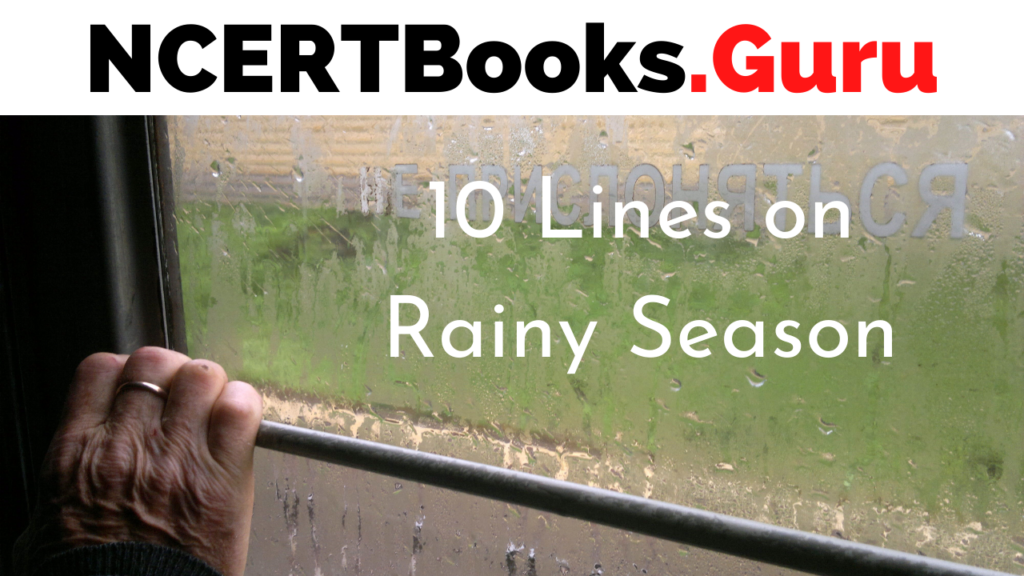10 Lines on Rainy Season: A season that mostly categorized by heavy showers and pleasant weather is the Rainy Season or monsoon. Being an agrarian economy and to provide enough irrigation for crops to grow, India heavily depends on the Rainy Season. Rains replenish Mother Nature and bring a sense of calmness and tranquillity in manifold ways.
The summers calmness mixed with the cool breeze like the winters. Spending a relaxing time with our loved ones, while sipping on hot tea, relishing the scent of showers is usually the highlight of the day. From jumping in puddles and peacocks dancing in the rain, this season has it all.
Enhance your vocabulary and writing skills with 10 Lines Essays available. Spark up the creativity in you and access various Topics on 10 Lines all in one place.
Set 1 – 10 Lines on Rainy Season for kids
- The wet season in the Subcontinent of India is called popularly as Monsoon.
- Mausim, an Arabic word is the origin of the English word Monsoon.
- Mausim in Arabic roughly translates to Season in English.
- In India’s various Subcontinent, the rainy season is not a fixed season due to the heavy to scanty rainfall experienced throughout the country.
- At various times, the rainy season can come over the Indian Subcontinent.
- The rainy season is succeeded by the season of autumn.
- The rainy season is preceded by the season of summer.
- Due to the presence of relatively low pressure in the Indian Subcontinent, Monsoons emerges.
- People use umbrellas and raincoats to avoid rain in the monsoons.
- For the people living in Indian Subcontinent, the monsoon is the lifeblood season.
Set 2 – 10 Lines on Rainy Season for School Children
- The monsoons are quite unpredictable and variable over the Subcontinent of India.
- The Monsoon usually weakens from the month of August.
- Over the various Indian Subcontinent, the monsoons are triggered by the summer season.
- Due to the relatively low-pressure trough created over the various Landmass of India, the monsoons come over India’s continent.
- From the high-pressure area, winds keep rushing from the seas and other water bodies.
- The low-pressure areas on the lands usually attract these winds.
- The hot summers create the high-pressure area.
- The monsoons continue for a couple of months in the Indian Subcontinent.
- This season is geographical terms called the monsoon of south-west summer.
- Originating over the Arabian Desert the monsoon winds extends up to the Thar Desert.
Set 3 – 10 Lines on Rainy Season for Higher Class Students
- The Monsoons influence and play a significant role in the economy of the Subcontinent of India.
- In India, the agricultural sector is entirely dependent on the onset of Monsoon.
- These Monsoons mostly influence the large variety of greenery and wildlife in the country.
- The monsoon is sporadic and is essential for crop growth across the country.
- The Western Ghats of India usually receive heavy rainfall every year along with parts of West Bengal, Meghalaya, Tripura and Kerala’s coasts.
- Due to the presence of several mini ranges, the west of the Eastern Ghats gets very little rain.
- Rajasthan receives some rainfall due to the presence of the Aravalli Range.
- Watershed development during the rainy season is heavily reliant on the presence of proper rains.
- India is an agriculture-based country, and so the GDP of India is also heavily reliant on it.
- For maintaining groundwater levels across the country, the monsoons are essential.
Frequently Asked Questions on Rainy Season
Question 1.
Are Monsoons usually erratic over the Indian Subcontinent?
Answer:
Yes. The monsoon season usually lasts three months, from the month of June to September. More than 70% of the total rainfall falls in these months. Because of its agriculture sector, monsoons are of particular strategic importance to India. There are several reasons scientists assert that climate change has made India’s monsoons more erratic.
Question 2.
Are Monsoons is bringing in changes or helpful in the setup of agricultural?
Answer:
Yes. The agriculture in the Subcontinent of India is heavily reliant and dependent on the Monsoon. In fact, the places receiving very scanty rainfall have red soil or laterite that requires a lot of irrigation and maintenance.
Question 3.
Are the Monsoons sporadic in nature?
Answer:
The monsoons are uncertain and erratic over most parts of the country. In most cases, the monsoons hit the Subcontinent of India in the month of late May or early June, but many times the monsoons can also come over the country in the month of July or August.
Question 4.
Is the Monsoon one of the notable seasons of the country?
Answer:
Yes, Monsoons are very much felt and prominent across the country.The rainy season hits in the month of June for most years, but the monsoons can be pushed back to August on certain occasions.
